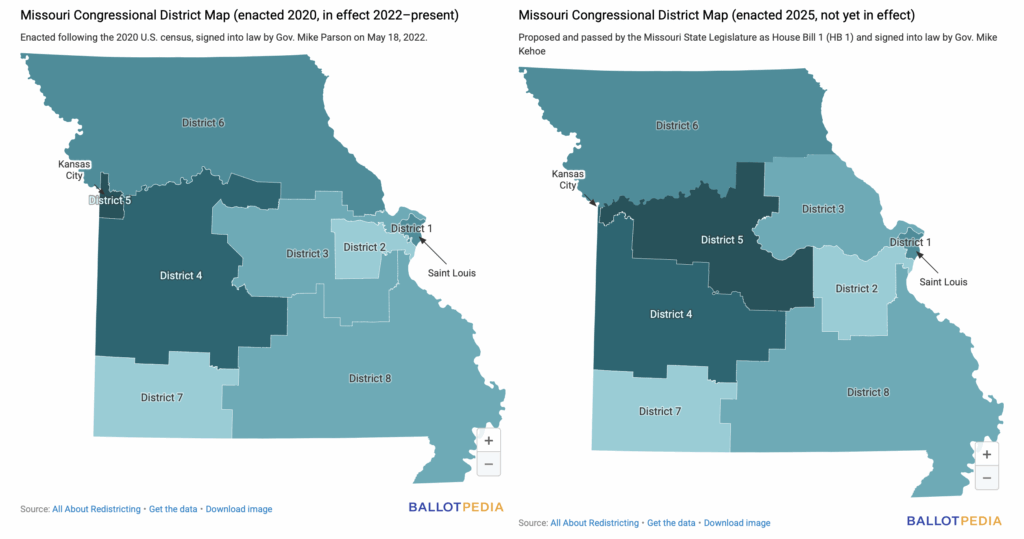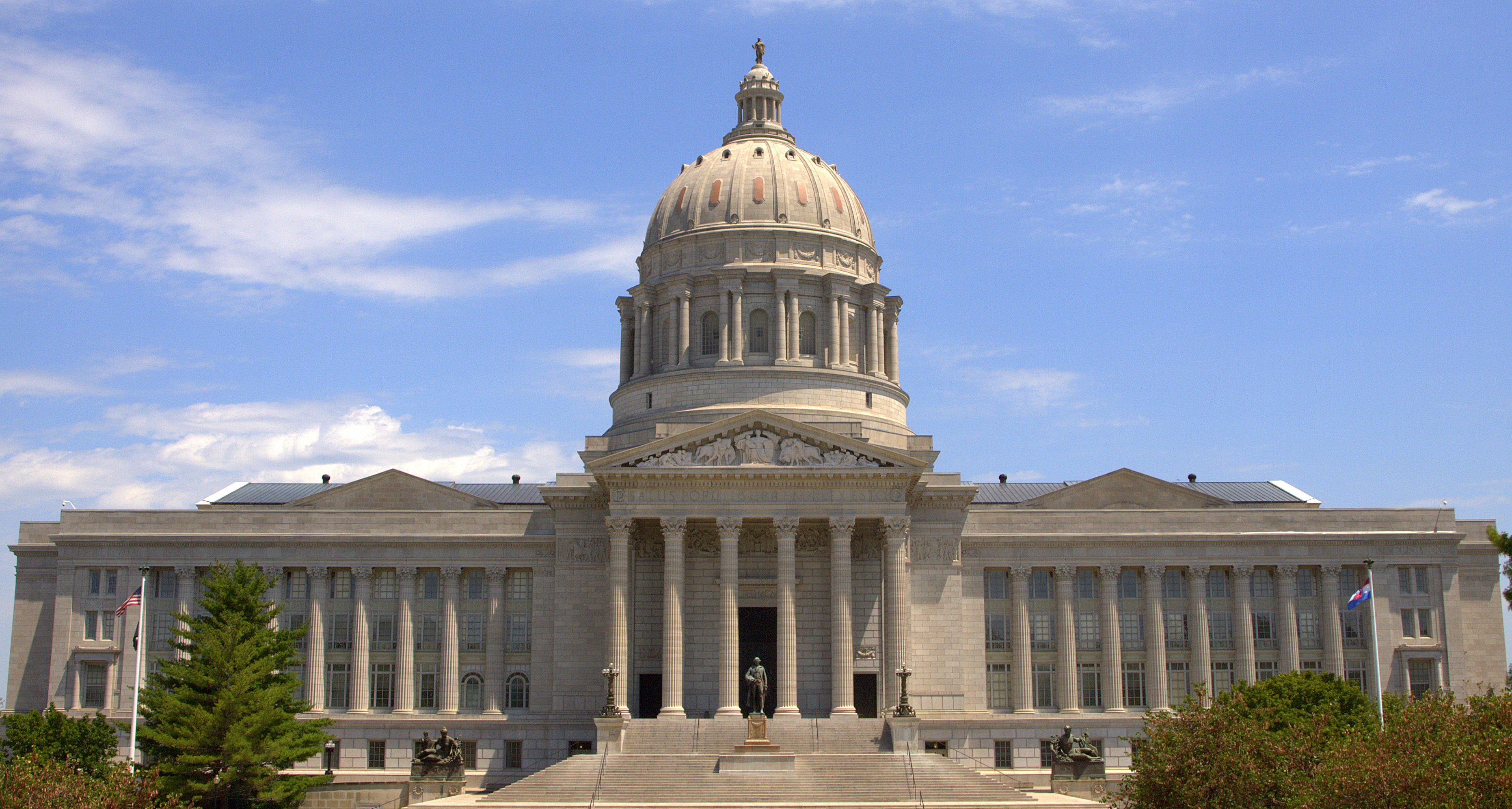In Missouri, signatures are being gathered for a veto referendum to place the newly redrawn congressional district map on the 2026 ballot.
A veto referendum is a citizen-initiated ballot measure that asks voters whether to uphold or repeal an enacted law. Placing the map on the ballot would mean it would not go into effect unless voters approve it in 2026, either at the general election or at an earlier special election.
Gov. Kehoe signed the new congressional map—passed as House Bill 1 (HB 1) during a special session of the General Assembly—into law on Sept. 28, 2025. Gov. Kehoe said, “We believe this map best represents Missourians, and I appreciate the support and efforts of state legislators, our congressional delegation, and President Trump in getting this map to my desk.” President Trump said the map would "deliver a gigantic victory for Republicans in the ‘Show Me State,’ and across the country" and provide an “... opportunity to elect an additional MAGA Republican in the 2026 Midterm Elections.”
U.S. Rep. Emanuel Cleaver (D-5), whose district includes Kansas City, responded to the change, saying, "President Trump’s unprecedented directive to redraw our maps in the middle of the decade and without an updated census is not an act of democracy — it is an unconstitutional attack against it." Ken Martin, chair of the Democratic National Committee (DNC), said, "The DNC won’t stand idly by as Republicans try to take the power away from the people — that’s why we’re partnering with Democrats on the ground to ensure Missourians choose their maps, not Trump or his Republican enablers."
HB 1 would make its most significant changes, in terms of partisanship, in the Kansas City area. Currently, most of Kansas City is contained within the 5th congressional district, but the new map would split the city across multiple districts.
Currently, Missouri has eight congressional districts. Republicans hold six of them—Districts 2, 3, 4, 6, 7, and 8—while Democrats represent Districts 1 and 5. The existing map was drawn after the 2020 U.S. Census, approved in 2022 by the Missouri General Assembly as House Bill 2909, and signed into law by Gov. Mike Parson on May 18, 2022. It was first used in the 2022 midterm elections.

The HB 1 map "breaks up a Democratic-held district in Kansas City and gives Republicans an advantage in seven of the state's eight U.S. House of Representatives districts," according to Reuters writer Joseph Ax. According to Inside Elections writer Nathaniel Rakich, "the old map had six seats that were R+10 or redder and two seats that were D+10 or bluer — and no seats in the competitive zone in between. This resulted in a congressional delegation that has consisted of six Republicans and two Democrats since 2013. The new map, however, features seven districts with a Baseline of R+10 or redder and leaves just one seat that is D+10 or bluer. There are still no seats between D+10 and R+10."
The People Not Politicians campaign first filed referendum petitions on Sept. 12, 2025. However, on Sept. 26, Secretary of State Denny Hoskins (R) rejected the proposed petitions. Attorney General Catherine Hanaway (R), in an opinion letter, recommended Hoskins reject the petition, saying, "A bill passed by the Missouri House of Representatives and Senate does not become ‘a law’ until it is either ‘approved by the governor’ or until the bill is not ‘returned by the governor within the time limits prescribed by this section.’"
In Missouri, proponents of a veto referendum can begin collecting signatures before the ballot language is issued. In 2022, the Missouri Supreme Court ruled that a state law barring signature gathering until after the referendum’s official ballot title was certified violated citizens’ constitutional right to use the referendum process. The court found that the law “dramatically reduce[d] the time available for the circulation of a referendum petition, both in theory and in practice.” Campaigns have 90 days following the legislature's adjournment to submit signatures. The statutes gave the government up to 51 days to prepare the official ballot title, which, according to the court, could leave campaigns with "39 days under the worst-case scenario" to collect signatures.
As of Sept. 29, the People Not Politicians campaign has reported $1.37 million in contributions. The top donors are the Global Impact Social Welfare Fund, contributing $500,000, as well as American Opportunity Action and Brick by Brick Foundation, each contributing $250,000.
Several states have begun a process of redistricting prior to the 2026 midterm elections. States redraw district lines every 10 years following the completion of the U.S. census. While every state redrew its district lines after the 2020 census, some states are revisiting redistricting ahead of the 2026 elections. As of Sept. 2025, nine states had congressional district maps that were subject to change before the 2026 elections, with Texas and Missouri officially redrawing their congressional maps. California also redrew its congressional district map, which is contingent upon voter approval of Proposition 50.
Missouri established the veto referendum process in 1908. Since then, voters have decided on 25 veto referendums in the state. The first was decided in 1914. The most recent was decided in 2018, when voters repealed Senate Bill 19, rejecting a right-to-work law. Of the 25 veto referendums, voters upheld only one, a 1920 measure enacting prohibition, while repealing the other 24.
Additional reading:


